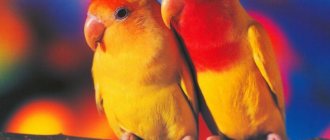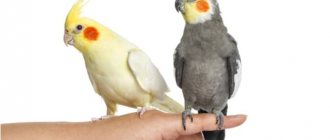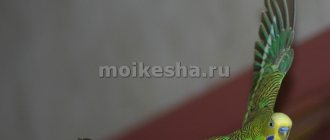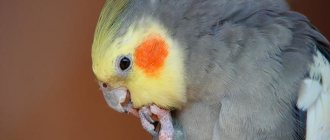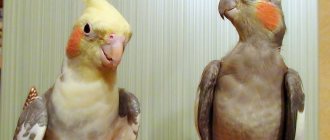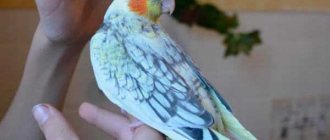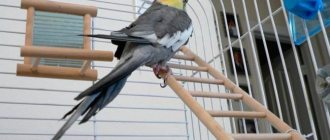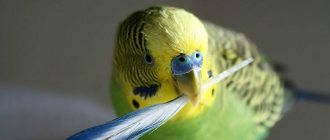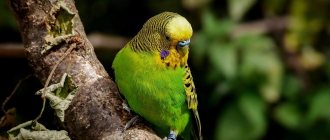The cockatiel chick grows very quickly and becomes similar to an adult parrot. Anyone who knows how to determine the age of a cockatiel can discern the external differences between them. Why is this skill so important for the buyer? Young parrots are easier to adapt and tame, so the demand for them is higher than for older individuals. To get a young bird, you can contact a trusted breeder or learn to determine the approximate age by external signs. They are common to most parrots, and there are also species characteristics that are characteristic only of cockatiels.
Common signs for all parrots
Parrots of any species have a certain set of characteristics that suggest how many years the bird has lived. These are, first of all, external indicators:
- development of the skeleton and limbs;
- body size and weight;
- plumage.
In addition, chicks can be recognized by their voice timbre and speech abilities. Let's look at each of the features in a little more detail.
Voice
Young parrots do not know how to sing fully. They make various sounds, chirp stupidly, and try to imitate their older comrades. After some time, orderly bird “speech” appears, and by the onset of the mating season, the males begin to show themselves, performing intricate melodies. Each species of parrot has its own age. For example, cockatiels are ready to reproduce from nine months. In addition to mating songs, birds exhibit the ability to learn and perceive human speech.
Bone structure
This sign continues the theme of sexual maturity, but applies more to females than to males. Growing cockatiels of both sexes are similar in that they sit upright on their perches and their paws are close to each other. An adult female, sitting on a perch, spreads her legs wide and bends over. This means that her pelvic bones have spread enough and she is ready to lay eggs.
On a note! You can distinguish young birds from adult birds by the rigidity of their keels. The chicks have a fragile, graceful sternum. Mature parrots have a prominent, hard keel.
Limb development
The chick's paws are covered with delicate pink skin. The soles are smooth, without growths and corns. As the bird grows up, small scales appear on its paws, tightly adjacent to each other. The older the parrot, the coarser these scales are, the more intensely they flake. Although this indicator may also apply to a sick bird. Separation of the skin occurs with certain diseases, for example, knemidocoptosis.
Body size
Bird offspring grow quite quickly and after a few months reach the size of adults. If we know the average parameters of a given type of parrot, we can approximately determine the age of a particular bird. When deviating downward from the average body weight and size, it is obvious that this is a chick.
Note! A small, light parrot may turn out to be an adult. This happens if they try to sell a sick, emaciated individual that was poorly fed and kept locked up.
Plumage
Parrots of reproductive age have smooth, dense, well-groomed plumage. It becomes this way as a result of the bird’s constant concern for its appearance. Young parrots do not know how to properly care for their feathers, rearrange them one by one and smooth them. In addition, their juvenile molt may be prolonged, during which infant feathers are replaced by new, strong feathers. It should be noted that parrots molt at any age, and more intensely during illness.
Another indicator of age is a certain sloppiness of the bird. Inexperienced chicks may have their feathers stained with droppings. The color of the plumage is dull and unstable.
Conditions of detention
In general, cockatiels are unpretentious, but they still require certain conditions for comfort.
Did you know? Corellas distinguish all their chicks, even if they have absolutely identical colors, and moreover,
they assign names to them. Each chick receives its own unique sound combination, with which its parents call it throughout the entire period of growing up. As cockatiels grow older, they lose the ability to recognize their infant name.
Climatic
The maximum comfortable humidity for a cockatiel is 70%, temperature is within 23 degrees. Most living spaces have these parameters, so feel free to place a cage with a cockatiel in the room. Avoid drafts and direct sunlight, as under their influence the bird will become ill. The cockatiel cannot tolerate dust, so regularly carry out wet cleaning near the cage.
What should a cell be like?
The requirements for choosing a cage for cockatiels are as follows:
- The dimensions of the cage should be as spacious as possible. The more space the bird gets, the better it will feel. The minimum dimensions are 60 cm in height, 50 cm in width and 50 cm in depth;
- Give preference to vertical cages so that your pet can fly whenever he wants. Let him out for a walk around the apartment twice a day so that he doesn’t start feeling bored without moving;
- buy cages with a gap between the bars of 2–3 cm. If the gap is smaller, the bird may injure its long toes; if it is larger, the head or wing will get stuck;
- A prerequisite for a comfortable cage is wide, strong perches made of wood. Cockatiel chicks love to chew on perches, so the use of plastic accessories is unacceptable. Place them so that, while sitting on the perch, your pet can freely spread its wings.
Important! Curious cockatiels love a variety of toys, but you need to add them to the cage gradually so that the chick does not become stressed by a lot of unfamiliar things.
What should a cockatiel cage be like: video
Hygiene procedures and care
The cage should be cleaned daily. Sweep the remaining food out of it, remove droppings, wash the feeder and pour fresh food into it. Once a week, carry out general cleaning, placing the chick in a temporary cage - wipe the bottom and bars. Every month, disinfect all surfaces of the cage, wash toys and accessories in soapy water.
Did you know? In the wild, cockatiels exhibit a remarkable addiction to alcohol. They become intoxicated by gorging themselves on fermented fruits or nuts, and then fly around uncontrollably and become rowdy. In Australia, every now and then there are whole “rains” of drunken parrots, during which the birds lose their orientation and fly into residential areas of cities. At home, with an open drinking bowl freely available, these cunning creatures can prepare their own mash by throwing pieces of fruit into the water and waiting for them to ferment.
These birds' claws grow throughout their lives, and there is no way to grind them down in a cage, so trim them once a month with a cat's nail clipper. While trimming, be careful not to touch the blood vessel that supplies the nail. Chicks are sensitive to stress, remember unpleasant sensations, and repeating the haircut next time will be problematic.
There is no need to wash the cockatiel under running water and with detergents. The bird takes good care of itself and cleans its dry plumage on its own. From time to time she needs to give her a spray bottle shower. If your pet is seriously dirty, you can put a bath in its cage with a weak soap solution - the chick will wash itself in it and then dry.
What signs are used to determine the age of cockatiels?
We have looked at the general signs, now let’s turn to the appearance of the Corella parrot. He has outstanding features by which age is judged:
- cheek spots;
- crest;
- eyes;
- paws and claws;
- tail;
- beak;
- behavior.
Not every ornithologist knows how to determine the age of a cockatiel parrot with an accuracy of one year, not to mention a simple fan of ornamental birds. It is possible to say more or less reliably how many months a parrot is, and also to identify an elderly bird among the young.
Cheeks
Naturally colored cockatiels have orange round spots on their cheeks. Some mutations also have similar markings, such as lutino or mottled. With age, these spots increase in diameter and become brighter. It is impossible to judge the age of the white-faced cockatiel based on this characteristic, since this mutation does not have spots under the eyes.
Tuft
You can find out how old a cockatiel is by looking at its crest. Already from the first days of life, the chick has the rudiment of a future forelock on the crown of its head. At first, the chick looks like a dragon with a jagged head. Every day he becomes more and more like a parrot. The crest grows, is framed by new feathers, and takes on the appearance of a crown. In young birds the crest is lush and tall, while in older birds it is fully formed, long, curved along the neck. Closer to old age, the cockatiel parrot develops a bald patch under the crest.
Eyes
You can determine the age of a cockatiel by paying attention to the color of its eyes. In its youth, the parrot looks at the world with large, shiny black eyes. Over time, the iris lightens to a deep brown color. As parrots grow up, the glossy shine in their eyes disappears. Cockatiels with the lutino mutation are born with red eyes that gradually darken, but the reddish tint remains. Many birds with this mutation have a brown or gray iris.
Paws and claws
Young cockatiels have extremely delicate toes that are not strong enough. It seems that they can wrap themselves into unimaginable positions. Young animals give themselves away by frequently falling from perches, as they do not know how to sit firmly before going to bed. The older the bird, the better it controls its legs and takes a stable position on the perch.
The skin on the paws is light and smooth. Later, scales form on it. The surface layer of the skin is constantly renewed, as a result of which the scales peel off and grow back. In elderly cockatiels, the legs may be wrinkled and rough to the touch. The chick's claws are small and pinkish. As the parrot grows, the claws also grow, thicken, strengthen and darken (except for certain mutations - lutino’s paws and claws are always light).
This is interesting! Based on the length of the claws, it is impossible to say with certainty about the age of the cockatiel. Some birds grab the perches in such a way that the claws remain suspended and do not grind down. Others move actively, climb the bars of the cage, cling to the ropes. These parrots will have noticeably shorter claws.
Tail
The Corella parrot looks graceful and elegant due to its long wings neatly folded along the back. At the point of contact, they form a straight line, which is continued by the same long, thin tail. In growing birds, the tail feathers are much shorter and not as orderly.
Beak and wax
The color of the beak must be considered in combination with the color: young and adult lutinos are characterized by a light tone of horny tissue, while in natural cockatiels the beak darkens with age. The older the naturally colored parrot, the more cloudy the color of its beak. The cere of a young parrot is convex and tender to the touch. In mature birds, separations, cracks, and growths appear on the beak. The cere shrinks, smoothes out, and against its background the nostrils become more noticeable.
Behavior
Every owner wonders how to find out the age of a cockatiel. Partial conclusions can be drawn from the pet’s habits. The young bird is open to everything new, but at the same time afraid of everything. He calmly approaches the person, but immediately jumps away, frightened by the outstretched hand. He is wary of toys, but persistently tries to explore them. When feeding, it scatters food in all directions and splashes water. He walks awkwardly, flies little, and mostly moves on his paws. While sleeping, he often falls off the crossbar.
Birds in their prime are active and cheerful. Males express their dominant position: they attack rivals, court females, and defend territory. Corella, who has lived enough years, behaves sedately. She sleeps more often and longer, and is less interested in what is happening around her. To find out the age of a parrot by its behavior, you need to observe it. This is quite difficult to do while in a pet store. Therefore, you have to contact the seller and make your choice based on the appearance of the parrot.
Next, let's talk about what other points should be taken into account when buying a cockatiel.
other methods
You can determine the age of a cockatiel not only by its appearance, but also by other characteristics: behavior and voice.
Singing
Chicks are often silent. Sometimes they make a quiet “kwi-kwi” sound.
Respectable parrots scream quite loudly. Occasionally their singing resembles the sounds of a car siren. It is noteworthy that when males preen, they emit original long and drawn-out melodies. This is how they try to impress the female.
Read also
How do half-parrots differ from budgerigars?
Buying a young cockatiel
Cockatiels are very popular as pets. Buying a cute parrot is not at all difficult - these colorful birds are sold everywhere. You can hope for a successful choice of a parrot if you come to a specialized nursery or a reliable, honest breeder for your purchase. There is also an opportunity to find a good bird in a pet store, because birds get there from the same breeders.
When looking closely at the individuals offered to choose from, pay attention to external signs of age: plumage, eyes, crest, beak and paws. For representatives of mutation colors, feather color is important. These cockatiels acquire permanent coloration after two molting cycles. The first stage begins at 3-4 months and lasts about six months. The second moult is completed by two years.
You should not buy an adult bird, as it may turn out to be uncooperative and unsociable. It is best to take a chick at the age of 2-3 months, when it can already fly and feed itself. He gets along without his parents, explores the world, and besides, it’s much more interesting with a small parrot.
Plumage
The young animals have a slightly unpresentable appearance - the newly appeared feathers are slightly ruffled because they do not fit tightly to the body. The tail feathers are short, while adult birds have long, luxurious feathers.
Read also: How to determine nationality by DNA?
The color of pets' feathers before the first molt, up to three or four months, is not so bright. Only after twelve months, when the change of plumage ends, does the Corella parrot acquire the coloration of an adult bird. Pets with mutational feather colors finally acquire adult color by the age of two.
Very often, parrots pluck their feathers during molting, trying to speed up the unpleasant process. Be careful when choosing a pet - sometimes sick birds engage in self-plucking. Always look at the general condition of your cockatiel. If he looks bad and sits in one place, it is better to buy another parrot, or even better, from another store. Many avian diseases are contagious and quickly spread to other pets.
How old do cockatiels grow?
Cockatiel chicks are born weighing only a few grams, but they grow literally “by the hour.” Increased growth occurs in the first month of life. Next, the bird acquires a large amount of fluff and feathers, and one gets the impression that it is growing. But this is an illusion created by the increasing volume. By the year the bird gains normal weight, on average 80 g, and the length of its body by this time is 30 cm including the tail. Sexual maturity occurs in males at 9 months, in females - a little later.
It is difficult for an inexperienced owner to determine what age a parrot has reached. This task is much easier for breeders for whom raising parrots is part of their life. But even professionals find it difficult to answer how old an adult cockatiel is, accurate to the nearest year.
Feeding the chicks
There are ready-made feed mixtures for cockatiels; they are balanced in nutrients and vitamins and can serve as the only food for birds.
If you don’t trust store-bought food, prepare your pet’s diet yourself:
- include grains, oilseeds, nuts and berries;
- Give tropical fruits dried, apples and pears raw.
Find out in more detail what you can feed parrots, what treats to give, what to do if they are poisoned.
Cockatiel chicks are prohibited from:
- avocado;
- potato;
- citrus seeds;
- drink coffee and strong tea.
The water in the drinking bowl should always be clean and fresh. A closed drinking bowl is preferable to a bathtub, since the bird actively moves in the cage and litters a lot.
